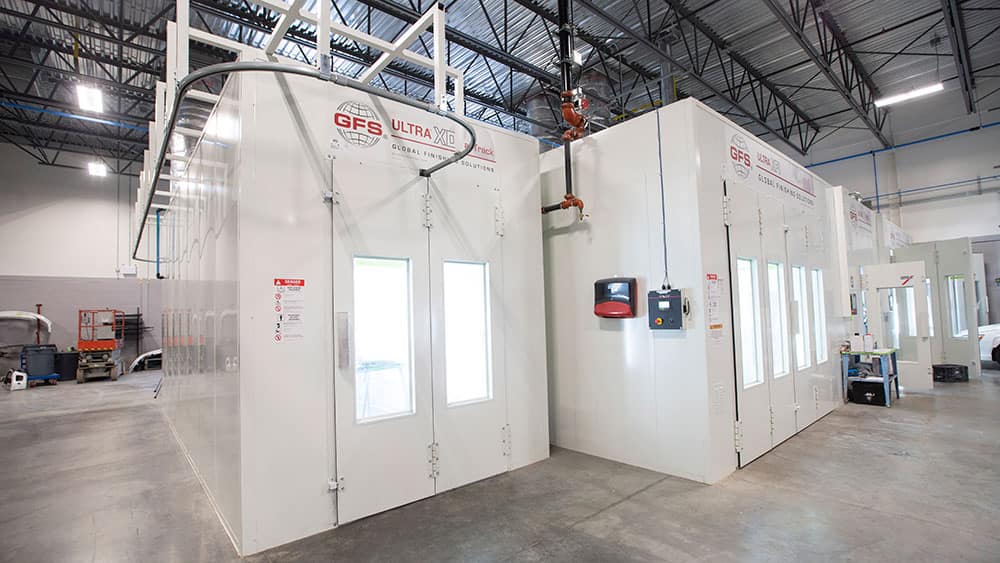
Regulating the temperature in your paint booth regardless of the temperatures outside is important to ensure consistency for both spraying and curing, which increases efficiency and reduces rework. Luckily, there is a mode for that — and now is the ideal time to activate it.
With summer/winter mode on Global Finishing Solutions (GFS) Air Make-Up Units (AMUs), a baseline temperature for the paint booth is more easily established. This eliminates some of the problems associated with frequent temperature fluctuations, keeping your finishing operation running smoothly even as the seasons change.
Summer/winter mode comes standard on many GFS control panels. Summer mode should be turned on in the spring, typically in April, when cool mornings can give way to warm afternoons. The flip to winter mode is best in the fall, usually in October, when the weather is perhaps the most unpredictable.
In summer mode, the burner on the paint booth heater (such as the GUL2000 automotive paint booth heater from GFS) remains off when the booth is in spray mode. In winter mode, the burner turns on in spray mode via the control panel, providing heat and humidity control to the paint booth. With the burner on, you will experience a 10-degree bump above ambient temperature. For working on temperature-sensitive products, this is especially helpful. Plus, already having the burner on is a time saver when it comes time to cure.
The benefits of summer/winter mode are not as widely recognized in places where the weather is more certain, such as the humidity of Florida, the hot summers of Arizona or the cold winters of northern Minnesota. Summer/winter mode is most beneficial in places like Colorado and Wisconsin, where a 30-degree temperature swing in a few days — or even on the same day — is not uncommon. It is also invaluable for several weeks during the spring and the fall, when the burner can cycle on and off as the temperature rapidly changes.
“You simply hit a button on the control panel at the beginning of fall, and the burner automatically comes on, and you are back to your comfort zone for finishing,” said Bill Day, field trainer and auditor for GFS.
It is most expensive to run a paint booth in spray mode. Having the booth in summer mode during warmer temperatures ensures the burner stays off in spray mode. This saves on utility costs for the business and prevents the booth from becoming too hot for painters.
Summer/winter mode can be activated through the control panel on GFS paint booths. On GFS legacy products, a two-position switch turns summer/winter mode on and off. On newer PLCs, there is typically an icon on the touch screen interface that can be selected to be on or off.
In simple terms, maximizing summer/winter mode is merely conditioning the finishing environment to your desired state.
“How can I manipulate the environment to be as close to what I want it to be?” Day said. “You can still spray at 65 degrees when it is not 65 degrees outside. There is just a lot more thought that has to go into making the end product the same. Conditioning the air and keeping the environment consistent leads to your savings on the back end.”
Taking advantage of summer/winter mode on your paint booth air heater means your finishing operation will not be slowed by the large temperature swings that typically occur in the spring and fall. You can navigate changes in seasons without having to drastically change the way you operate your paint booth.
One of the best ways to highlight your business is through a story that you can share across your online platforms. It humanizes your business and shows that your business can make a meaningful impact. Your testimonial would be used as a project profile on the GFS Booth Blog and can be shared on your website and/or social media channels.
Complete this form and we’ll be in touch to showcase your company.

Shop a variety of GFS aftermarket products, including booth protection products and mobile accelerated curing units. And enjoy the convenience of fast and free ground shipping throughout the contiguous United States.

Located at GFS’ headquarters in Osseo, Wisconsin, the Center for Excellence is an innovative facility featuring an automotive refinish training center, as well as a separate space dedicated to technical product training.

GFS is continuously searching for talented, ambitious individuals to join our team. We aim to provide our employees with every opportunity to make an impact on the company and find their niche along the way — weather in a production, field services or an office position.